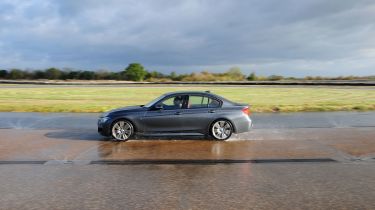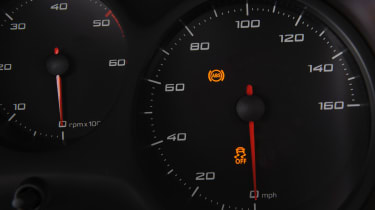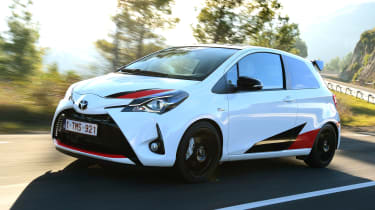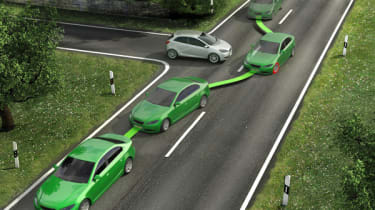What is ABS? Anti-lock brake systems explained
ABS is a vital part of any new car's safety equipment, and is an effective boost for braking. Here's everything you need to know...

The introduction of ABS - the anti-lock brake system, to give it its full name - was one of the most important developments in new car safety.
In simple terms, ABS uses electronics to detect and prevent wheel lock up. This helps a driver maintain control of a vehicle when braking in low grip situations, because a car's steering will still work when ABS is engaged. ABS gradually appeared as a safety feature on new cars from the 1970s onwards, while EU law has made it compulsory fitment on all cars built since 2004.
Most people are aware that their car is fitted with ABS, but far fewer know what it does and how it works. The basic principle is that sensors fitted to a car's wheels determine if one is on the verge of locking up under braking. If a wheel does lock, then hydraulic valves release to reduce braking pressure ever so slightly to prevent this happening. In many ways the electronics are performing cadence braking - where the driver pumps the brake pedal to prevent wheel lock. This allows the driver to maintain steering control, which is lost when the wheels are locked.
ABS history
While the concept of non-locking brakes has been around for a number of years, the first truly effective anti-lock braking systems have been around since the 1950s, when British firm Dunlop first developed its Maxaret system for use in aviation.
This hydraulic system improved aircraft stopping distances when landing, as it all but eliminated the risk of wheels locking, even on ice, and it dramatically reduced flat spotting and tyre blow outs, too. It didn't take long for vehicle engineers to realise that the system could also be beneficial on cars.
The first road car to feature ABS was the 1966 Jensen FF. The FF was the first production sports car to feature four-wheel drive, and it also used the Maxaret anti-lock system to improve stopping distances. However, the hydraulic system wasn't really suited to vehicle use, while the FF was too cumbersome and expensive to be a sales success.
• What is ESP stability control?

With the introduction of better electronics in the 1970s and 1980s, ABS was refined by firms such as Chrysler, General Motors and Bosch, while the 1985 Ford Scorpio was the first car to feature ABS across the range as standard.
Since then, firms have developed ABS for motorcycles, while EU legislation implemented in 2004 means that every new car sold in Europe must have ABS as standard.
How do ABS brakes work?
ABS is an electronic brake control system that works in principle like cadence braking, only it's much more effective. This advanced driving technique is useful on non-ABS equipped cars, as the driver pumps the brake pedal to regain steering control while also providing maximum braking.
The ABS system uses sensors to detect when one wheel is rotating at a different rate to the others. If the sensor registers that a wheel is turning more slowly under braking, then that's a sign the wheel is locking or about to lock. The electronics then reduce brake pressure by activating a relief valve, until it's equal with the other wheels.

If the wheel begins to lock again, the process is repeated, in the same way as pumping the brake pedal, although the electronics are sensitive enough that this can be repeated many times per second, whereas cadence braking by a driver can only really be repeated once or twice a second. You can tell if your car's ABS system is working if you brake heavily and feel the brake pedal judder under your right foot.
Modern ABS systems use a four-channel controller module that features individual sensors and relief valves on all four wheels - older variations that feature one, two or three channels would have sensors across a front or rear axle, depending on the layout of the vehicle.
ABS benefits
The improved braking provided by ABS is beyond doubt. Tests have shown that a car fitted with ABS braking on tarmac will stop in a far shorter distance than an identical non-ABS car, even if that car is being driven by somebody who is experienced in cadence braking.

The other benefit of ABS is that the car's steering will still work while using maximum brake pressure. In a car with locked wheels, the forward motion of the car will overcome the grip of the tyres and any steering lock that has been applied. But as the ABS-equipped car's wheels will still be rotating, the car will follow the direction of the steered wheels.
ABS problems
If you drive on loose surfaces, ABS can interfere with how easily you can stop your car. On loose dirt, mud or snow, or any low-grip surfaces, the anti-locking function can become confused, and the constant releasing that the electronics engage in can in fact extend stopping distances.
On loose surfaces, a locked wheel is more effective at stopping because it 'digs in' to help bring a car to a stop. That's why many off-roaders feature a special off-road mode, which reduces the effectiveness of the ABS or turns it off completely to boost low-speed grip.
If your car's ABS system is faulty, it will flash up an orange warning light on the dashboard. Common problems with ABS include damaged sensors and blocked release valves, although on the whole most cars with ABS will be reliable. If you do have ABS problems, then for the sake of safety, it's best to get your car checked by a garage or mechanic to get it fixed or repaired.
What are your experiences with ABS? Has it ever saved you from an accident? Let us know in the comments section below...
Find a car with the experts


